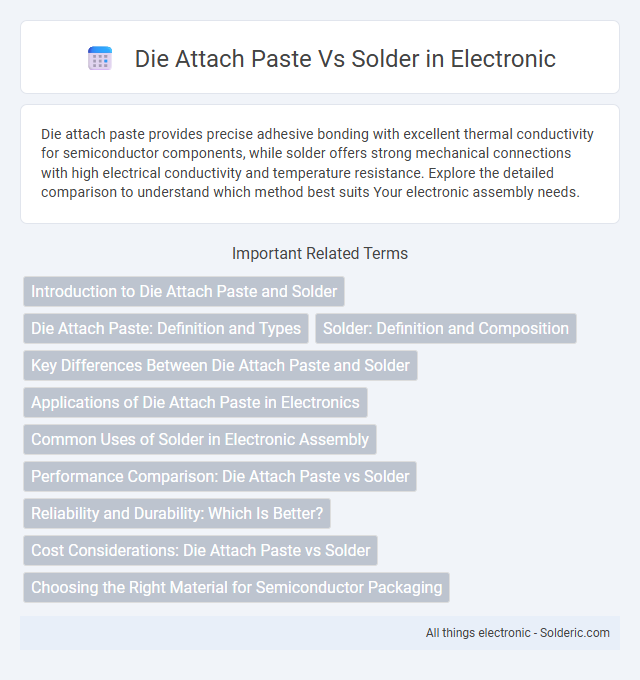Die attach paste provides precise adhesive bonding with excellent thermal conductivity for semiconductor components, while solder offers strong mechanical connections with high electrical conductivity and temperature resistance. Explore the detailed comparison to understand which method best suits Your electronic assembly needs.
Comparison Table
| Feature | Die Attach Paste | Solder |
|---|---|---|
| Primary Use | Semiconductor die bonding | Electrical and mechanical connections |
| Composition | Epoxy resin or silver-filled paste | Metal alloys (commonly SnPb, SnAgCu) |
| Application Method | Stencil printing or dispensing | Soldering (wave, reflow, or hand soldering) |
| Operating Temperature | Typically 150-180degC (curing) | Melting point 180-230degC |
| Mechanical Strength | High shear strength, good adhesion | Moderate mechanical strength |
| Electrical Conductivity | Conductive (if silver-filled) | High conductivity |
| Flux Requirement | Usually no flux needed | Flux needed to ensure good joint |
| Curing Time | Minutes to hours depending on process | Seconds to minutes during soldering |
| Typical Applications | Die attach in IC packaging | PCB assembly, wire bonding |
Introduction to Die Attach Paste and Solder
Die attach paste and solder are essential materials in semiconductor packaging, providing mechanical support and thermal/electrical conductivity between the die and substrate. Die attach paste consists of polymer resin loaded with conductive fillers like silver or gold, offering strong adhesion and excellent thermal stability for high-reliability applications. Solder, an alloy typically composed of tin, silver, and copper, creates metallurgical bonds with high electrical conductivity and ease of rework, making it suitable for various electronic assembly processes.
Die Attach Paste: Definition and Types
Die attach paste is a thermally conductive adhesive used to bond semiconductor dies to substrates, providing mechanical support and heat dissipation. Common types include silver-filled epoxy pastes, which offer excellent electrical and thermal conductivity, and silicone-based pastes, known for flexibility and high-temperature resistance. Your choice of die attach paste depends on the application's thermal management needs and mechanical stress tolerance.
Solder: Definition and Composition
Solder is a fusible metal alloy used to join electronic components to circuit boards, typically composed of tin, lead (in older formulations), silver, and copper. The composition of solder impacts its melting point, electrical conductivity, and mechanical strength, with lead-free variants increasingly preferred for environmental and health reasons. Your choice between die attach paste and solder depends on the specific thermal and mechanical requirements of the application.
Key Differences Between Die Attach Paste and Solder
Die attach paste and solder differ primarily in composition and application within semiconductor manufacturing; die attach paste consists of polymer resin mixed with conductive fillers like silver, providing mechanical strength and electrical conductivity for die bonding. In contrast, solder is a metal alloy used to create strong, conductive joints through melting and solidification, typically involving tin, lead, or lead-free alternatives. Die attach paste cures at lower temperatures and offers better stress absorption, whereas solder requires higher temperatures and results in more rigid joints, impacting thermal and mechanical reliability.
Applications of Die Attach Paste in Electronics
Die attach paste is extensively used in semiconductor packaging for attaching chips to substrates or lead frames, ensuring excellent thermal conductivity and mechanical strength. It provides reliable electrical conduction and is ideal for applications requiring precise placement and minimal void formation, such as LED modules, power devices, and MEMS sensors. Unlike traditional solder, die attach paste offers better process control and compatibility with sensitive components in advanced electronic assemblies.
Common Uses of Solder in Electronic Assembly
Solder is extensively used in electronic assembly for creating reliable electrical connections between components and printed circuit boards (PCBs), ensuring optimal conductivity and mechanical stability. It is favored for applications requiring strong, durable bonds, such as attaching leads, terminals, and surface-mount devices. Your choice of solder alloy and flux impacts the efficiency of thermal and electrical performance in electronic assemblies.
Performance Comparison: Die Attach Paste vs Solder
Die attach paste offers superior thermal conductivity and enhanced mechanical stability compared to traditional solder, making it ideal for high-power semiconductor applications. Solder provides excellent electrical conductivity and is easier to process for mass production but generally exhibits lower thermal performance and weaker mechanical bonds. Understanding your specific thermal and mechanical requirements helps optimize the choice between die attach paste and solder for reliable semiconductor assembly.
Reliability and Durability: Which Is Better?
Die attach paste offers superior reliability and durability compared to solder due to its excellent thermal stability and strong adhesive properties that prevent delamination and mechanical stress failures. Solder can be prone to fatigue and cracking under thermal cycling, reducing long-term performance in high-reliability applications. Your choice depends on the specific operating environment, but die attach paste generally provides enhanced durability for demanding electronic assemblies.
Cost Considerations: Die Attach Paste vs Solder
Die attach paste generally offers a lower-cost solution compared to traditional solder due to reduced material usage and simplified processing steps. Solder requires higher temperatures and more energy, increasing manufacturing expenses and potential equipment wear. For high-volume production, die attach paste can improve cost efficiency by minimizing thermal stress and enabling faster cycle times.
Choosing the Right Material for Semiconductor Packaging
Selecting the ideal material for semiconductor packaging depends on thermal conductivity, mechanical strength, and electrical performance, where die attach paste offers superior flexibility and ease of application compared to traditional solder. Die attach paste provides enhanced damping of thermal stresses and better compatibility with sensitive components, whereas solder ensures robust mechanical bonds but may lead to higher thermal resistance and potential joint fatigue. Evaluating factors such as operating temperature, reliability requirements, and production efficiency guides the decision between die attach paste and solder for optimized semiconductor device performance.
Die attach paste vs Solder Infographic

 solderic.com
solderic.com